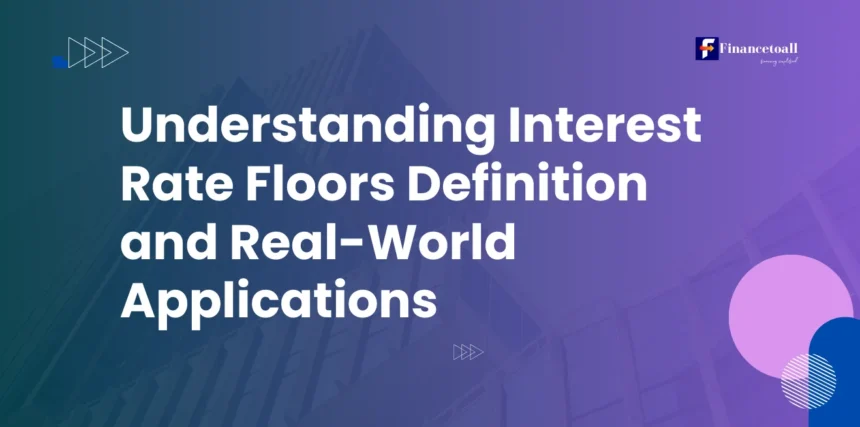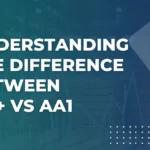An interest rate floors plays a critical role in protecting lenders and investors by setting a minimum threshold for the interest rate they can receive on a financial product, such as loans or bonds. These instruments are widely used in floating-rate loans, bonds, and derivatives like interest rate swaps. Essentially, the interest rate floor ensures that lenders or investors will receive a certain minimum interest rate return, even when market interest rates fall below the specified floor.
Interest rate floors are not standalone products; they are deeply embedded in various financial contracts, including adjustable-rate loans (ARMs), corporate bonds, and complex derivative contracts. By defining a floor rate, these instruments help mitigate risks in a volatile interest rate environment, providing stability and predictability for financial institutions, companies, and individual investors alike.
In this Article, we will cover the workings of interest rate floors, their implications for borrowers and lenders, and the various ways they are applied in finance. We will also explore the differences between interest rate floors and interest rate caps, their real-world applications, and the broader financial implications of their use.
Defining Interest Rate Floor in 1 Line:
An interest rate floor is the lowest interest rate that can be charged on a loan or earned on an investment, even if market rates go lower. It protects lenders and investors by guaranteeing a minimum rate of return.
Key Takeaways
What Is an Interest Rate Floor?
Interest Rate Floor Defined
An interest rate floor is a financial provision or instrument embedded in a loan, bond, or derivative contract that sets a lower limit on the interest rate applied to that financial product. This minimum interest rate ensures that even if the reference interest rate (such as LIBOR, SOFR, or Euribor) falls below a certain level, the lender or investor will still receive at least the agreed floor interest rate.
For example, in a floating-rate loan, if the benchmark interest rate is 1% but the interest rate floor is set at 2%, the borrower must still pay 2%, not 1%. This provides protection to lenders and investors, ensuring a minimum income from their investments or loans.
Interest Rate Floor in Finance
In finance, the interest rate floor is a critical tool used to protect against declines in interest rates. Financial institutions, including banks and investment firms, often include interest rate floor provisions in rate loan agreements to maintain profitability even when market interest rates decrease significantly.
For lenders, this provision ensures a guaranteed return, while borrowers might have to accept slightly higher borrowing costs due to the additional security provided to the lender. Interest rate floors are often seen in corporate loans, commercial real estate financing, and structured products where interest rate volatility can impact returns.
LIBOR Rate Floor Explained
One of the most common applications of the interest rate floor is in contracts tied to the LIBOR (London Interbank Offered Rate). The LIBOR rate floor ensures that the interest rate on a floating-rate loan, bond, or derivative contract does not fall below the agreed floor, even if LIBOR declines. With the ongoing transition from LIBOR to SOFR (Secured Overnight Financing Rate), the application of interest rate floors remains an important consideration for financial contracts, despite changes in the benchmark.
How Interest Rate Floors Work
Function of an Interest Rate Floor
The core function of an interest rate floor is to establish a minimum interest rate that applies to floating-rate financial products. Floating-rate products, such as variable rate loans, bonds, or adjustable-rate mortgages (ARMs), typically tie their interest rates to a specific benchmark, like the LIBOR, SOFR, or Euribor.
When the benchmark rate declines, the interest rate floor prevents the borrower’s payments from falling below a certain level, which ensures that the lender continues to receive a minimum return on their investment. This is particularly beneficial in periods of low market interest rates, where lenders would otherwise face reduced earnings.
For example, consider a rate loan contract with an interest rate floor of 1.5%. If the benchmark rate tied to the loan drops to 1%, the borrower would still be required to pay 1.5%, thus maintaining the lender’s income.
Interest Rate Floor Contracts and Agreements
An interest rate floor contract is a formal agreement between the borrower and the lender that specifies the floor rate. These agreements typically include terms outlining the interest rate floor, how it is calculated, and under what conditions it applies. Interest rate floor provisions are negotiated and included in the broader loan or derivative agreements.
For lenders, including an interest rate floor provision in a contract ensures they are protected from market downturns and low-rate environments. Borrowers, however, may see these provisions as an added cost, as they prevent them from benefiting fully when interest rates fall.
Pricing and Valuation of Interest Rate Floors
Interest rate floor pricing depends on several factors, including the volatility of the interest rate, the time to maturity of the loan or contract, and how close the current rate is to the floor rate. As the likelihood of rates falling below the specified floor rate increases, the cost of the interest rate floor rises.
Financial institutions use models, such as the Black-Scholes model (often applied in derivative contracts), to calculate the pricing of floors. These models take into account factors like interest rate volatility, time horizons, and potential interest rate changes to determine the appropriate cost of the floor.
Purpose and Importance of Interest Rate Floors
Why Interest Rate Floors Are Important
The purpose of an interest rate floors is to provide a safety net for lenders and investors in a fluctuating interest rate environment. In periods of economic downturn or when central banks lower interest rates to stimulate the economy, interest rate floors ensure that lenders and investors still receive a guaranteed minimum return. This is crucial in maintaining their financial stability and profitability during uncertain times.
For borrowers, interest rate floors can serve as a predictable mechanism in their loan agreements, though they generally prefer lower interest rates. The key challenge for borrowers is that interest rate floors may lead to higher costs when rates are low, as they cannot fully benefit from falling market interest rates.
Interest Rate Floors in Adjustable-Rate Loans (ARMs)
In adjustable-rate mortgages and other adjustable-rate loan products, interest rate floors are included to limit how low the borrower’s interest can go. For instance, in an ARM, where the interest rate adjusts periodically based on the reference interest rate (such as LIBOR or SOFR), the lender may insert a floor rate to ensure that, regardless of how low the benchmark rate falls, they receive a minimum interest payment.
This is critical in long-term loan agreements, such as mortgages, where interest payments are expected to fluctuate. Without a floor, a sharp decline in interest rates could significantly reduce the lender’s return on investment. However, from the borrower’s perspective, a floor interest rate environment might prevent them from fully capitalizing on periods of low interest, leading to increased borrowing costs.
Comparing Interest Rate Floors and Caps
What is a Financial Floor and Cap?
Both interest rate floors and interest rate caps are risk management tools used in financial contracts to control the range within which interest rates can fluctuate. While the interest rate floor establishes the minimum rate below which the interest cannot fall, the interest rate cap sets a maximum limit on how high interest can rise. These tools are especially important in floating-rate products, where the interest rate is tied to a volatile benchmark.
For borrowers, an interest rate cap provides protection from rising rates by limiting the upper bound of their payments. Lenders, however, use interest rate floors to protect against the downside risk of falling rates. Together, caps and floors can be combined to create an interest rate collar, which establishes both a lower and upper boundary for interest rate fluctuations. This structure provides a controlled range of possible interest rate outcomes, helping both lenders and borrowers manage risk.
Key Differences Between Interest Rate Floors and Caps
- Interest Rate Floors: Protects lenders by ensuring a minimum interest rate return.
- Interest Rate Cap: Protects borrowers by setting a maximum interest rate they must pay.
Interest Rate Cap Contracts
An interest rate cap contract provides protection to borrowers by limiting the extent to which their interest payments can increase over time. For example, in an adjustable interest rate loan, the borrower may agree to a cap that ensures their payments won’t exceed a certain percentage, even if the benchmark rate soars. This offers predictability and shields borrowers from the negative impact of rising interest.
In contrast, a rate loan contract with an interest rate floors ensures the lender receives a minimum payout, offering security in a low-rate environment. Both floors and caps are commonly used in rate loan agreements for commercial real estate, corporate financing, and rate home loans.
Interest Rate Collars
An interest rate collar combines both a floor rate and a cap rate in a financial contract, creating a structure where the interest rate is allowed to fluctuate between the two defined limits. This offers both borrower and lender some degree of predictability while sharing the risks of interest rate volatility.
Interest Rate Floors in Derivatives and Swaps
Interest Rate Floor Swaps and Floorlets
In the world of derivatives, an interest rate floor is often applied in interest rate swaps. An interest rate swap involves exchanging fixed interest payments for floating ones, or vice versa. In these agreements, the interest rate floor acts as a safeguard, ensuring that the floating-rate payer does not receive less than a specific minimum interest rate.
Within the context of derivatives, floorlets are small components of a larger interest rate floor contract. Each floorlet represents the right to receive payments if the interest rate falls below a certain level during a specific time period. These floorlets are often used in interest rate swaps and options, allowing parties to mitigate their exposure to interest rate changes.
For example, in a floor interest rate environment, where interest rates are volatile and likely to drop, floorlets provide the holder with protection by paying out the difference between the specified floor rate and the actual interest rate. This is particularly important in structured interest rate derivative contracts, where minimizing risk is a key objective.
Real-World Applications of Interest Rate Floors
Interest Rate Floors in Loan Agreements
Many financial institutions incorporate interest rate floors in loan agreements to protect themselves from declining rates. For example, in commercial real estate lending, banks often include a rate loan floor provision that prevents the interest rate from falling below a certain threshold, even if the benchmark rate tied to the loan, such as LIBOR, falls.
Similarly, interest rate floor provisions are common in leveraged loans, where the borrowing terms allow the lender to recoup at least a minimum rate of return despite the volatility in market conditions. Interest rate floor contracts ensure that even in a low-rate market, the lender’s returns are safeguarded.
Corporate Financing and Bonds
Corporations issuing bonds often include interest rate floor provisions in their debt contracts to make these instruments more attractive to investors. These floors ensure that investors will continue to receive a minimum return on their investment, even when interest rates fall. This adds security for investors and encourages bond purchases, particularly in uncertain economic conditions.
Adjustable-Rate Mortgages and Home Loans
In the context of adjustable-rate mortgages (ARMs), lenders frequently include interest rate floor agreements to prevent mortgage rates from falling too low. This is critical in rate home loans, where fluctuations in interest rates could otherwise drastically reduce the lender’s return. Homebuyers with ARMs may find that, due to the floor interest rate, their payments remain stable or higher than market conditions would dictate.
Impact of Economic and Market Conditions on Interest Rate Floors
The Role of Central Banks and Interest Rate Floors
Central banks, such as the Federal Reserve or the European Central Bank, play a significant role in influencing interest rates and, by extension, the relevance of interest rate floors. During times of economic downturns or crises, central banks often lower interest rates to stimulate the economy. In these scenarios, interest rate floors become crucial for lenders and investors, ensuring they maintain a minimum return even as rates plummet.
For example, following the 2008 financial crisis and the COVID-19 pandemic, central banks around the world reduced rates to historic lows. During such periods, interest rate floors provided lenders and investors with a stable income stream, regardless of how low the underlying interest rates fell.
Regulatory Considerations and the Transition from LIBOR to SOFR
Interest Rate Floor Impact in the LIBOR to SOFR Transition
As global financial markets transition from LIBOR to SOFR, the use of interest rate floors in financial contracts will need to adapt. LIBOR, which was the primary benchmark for most rate loan contracts, is being phased out, with SOFR emerging as the new standard. While this shift impacts how interest rate floors are calculated, the principle remains the same: lenders and investors will continue to use floors to protect their returns.
Regulatory bodies around the world are overseeing this transition, ensuring that interest rate floor agreements in existing contracts are adjusted to reflect the new benchmarks. This transition poses challenges for both lenders and borrowers, as it may require renegotiating loan terms to ensure that floors, caps, and collars remain effective under the new reference interest rate.
Consumer Protection Laws and Interest Rate Floors
In certain markets, consumer protection laws regulate the use of interest rate floors in residential mortgages. In particular, regulators scrutinize adjustable-rate mortgage contracts to ensure that borrowers are not unduly disadvantaged by the inclusion of a floor rate. These laws ensure transparency and fairness, preventing predatory lending practices where floors may lock borrowers into paying more than the prevailing market rates.
Financial Implications of Interest Rate Floors for Borrowers and Lenders
How Interest Rate Floors Affect Borrowers
For borrowers, interest rate floors represent a potential cost. In a low-interest rate environment, borrowers with floor interest rate provisions may find themselves paying more than they would with a floating-rate loan that lacks a floor. This is because the minimum interest rate set by the floor prevents the borrower from benefiting fully from declining market interest rates.
However, some borrowers may still agree to floors in exchange for more favorable terms elsewhere in the loan contract, such as a lower fixed-rate cap or flexibility in repayment schedules. Borrowers must carefully weigh the costs and benefits of including a floor in their adjustable-rate loan contracts, especially when interest rates are volatile.
How Interest Rate Floors Benefit Lenders
For lenders, interest rate floors are a critical risk management tool. In times of economic uncertainty or when central banks engage in aggressive monetary policies, interest rates can fall to levels that jeopardize lenders’ profitability. By including floor rates in their rate loan products, lenders ensure a steady stream of income, even when interest rates drop significantly.
This minimum rate guarantee provides stability and predictability, which is essential for financial institutions that rely on interest income to fund their operations. Interest rate floor agreements also enable lenders to offer variable rate loans while still maintaining some control over the risk of rate fluctuations.
Conclusion: The Role of Interest Rate Floors in Modern Finance
In summary, interest rate floors play an essential role in protecting lenders and investors from falling interest rates, ensuring a minimum return on loans, bonds, and derivative contracts. Whether applied in rate loan contracts, corporate bonds, or complex derivatives like interest rate swaps, floors provide financial stability in a volatile interest rate environment.
For borrowers, interest rate floors can add complexity and cost to their loan agreements, especially in periods of low rates. However, these provisions also offer a degree of predictability and structure, which can be valuable in certain financial contexts.
As the global financial landscape continues to evolve, particularly with the ongoing transition from LIBOR to SOFR, interest rate floors will remain a key component of risk management strategies. Whether through adjustable-rate loans, bonds, or derivatives, these instruments will continue to shape the financial world by providing essential protections against the uncertainties of future interest rate changes.
Frequently Asked Questions (FAQ) About Interest Rate Floors
1. What is an interest rate floor?
An interest rate floor is a financial contract that sets a minimum interest rate below which the rate on a loan, bond, or derivative product cannot fall. It ensures that the lender or investor receives at least a specified minimum return, regardless of market interest rate movements.
2. How does an interest rate floor work?
In a financial contract with a floating interest rate, the interest rate floor prevents the rate from falling below a certain level. If the benchmark rate (such as LIBOR, SOFR, or Euribor) falls below the agreed floor, the borrower or the financial product still pays the minimum rate specified by the floor.
3. Where are interest rate floors commonly used?
Interest rate floors are commonly found in:
Floating-rate loans (such as commercial real estate or corporate loans).
Floating-rate bonds and notes.
Interest rate derivatives (such as swaps and options).
4. What is the difference between an interest rate floor and a cap?
An interest rate floor sets a minimum limit on how low the interest rate can fall, protecting lenders or investors. An interest rate cap, on the other hand, sets a maximum limit, protecting borrowers from rising interest rates. These two instruments can be combined into an interest rate collar, where both minimum and maximum limits are established.
5. Who benefits from an interest rate floor?
Lenders and investors benefit from interest rate floors because they ensure a minimum return on their loans or investments, even if interest rates fall. Borrowers do not directly benefit from floors, but they may prefer them for predictability in specific agreements.
6. What is a floorlet?
A floorlet is a component of an interest rate floor, typically used in interest rate derivatives. Each floorlet gives the holder the right to receive a payment if the interest rate falls below a specific level during a defined period.
7. How are interest rate floors priced?
The pricing of an interest rate floor depends on factors such as interest rate volatility, the time to maturity, and the difference between the current rate and the floor level. Financial models, such as the Black-Scholes option pricing model, are often used to calculate their value.
8. Why do borrowers agree to interest rate floors?
Borrowers may agree to interest rate floors as part of a larger loan agreement, especially in floating-rate loans. In exchange, they may receive more favorable terms elsewhere, such as lower fixed-rate caps or flexibility in repayment schedules. However, borrowers often pay a premium for loans with floors, which can be a disadvantage if rates remain low.








